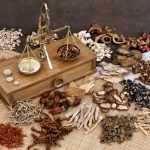A Place for Plants in Conscious End of Life
Robin DiPasquale, ND, RH (AHG)
From my point of view as a spiritual practitioner, I believe dying to be a great opportunity for people to come to terms with their whole lives; and I have seen many, many individuals take this opportunity, in the most inspiring way, to change themselves and come closer to their own deepest truth.
-Sogyal Rinpoche, The Tibetan Book of Living and Dying1
The circle of life is just that, a circle. It has a beginning (birth), a middle (life), and an end (death). Birth is often a joyful occasion, the arrival of a new being on the planet. The middle is life itself, with many transitions full of ups and down and a goal of maintaining some kind of equilibrium along the way. Death is the other end of the circle, the aspect that is least talked about, less visible in our Western culture, and full of many different emotions. The art of family medicine involves caring for the body, mind, emotions, and spirit through the entire circle of life. Women are cared for throughout the pregnancy and birth of their children. Children are cared for through their years of growth, illnesses, and milestones. Adults seek care for disease prevention and wellness, as well as treatment of acute and chronic disease states. As people age, their need for care progresses to tending to them through the dying process. This article will look at some ways that plant medicine can work with the experience of the end of life, bringing more awareness and consciousness to our care of dying people and their loved ones.
One question that hovers when someone has been diagnosed as having a terminal illness, or for some other reason steps into the active process of dying, is exactly what kind of naturopathic or therapeutic support does he or she need? How do we keep someone “relatively” well when he or she is moving slowly, or rapidly, toward death? What nutritional supplements do we continue to recommend to the patient? How long do we consider detoxification protocols? How do we decide which support is palliative and which support is perhaps impeding the dying process? Certainly, these questions are answered with thought and awareness of the goals of each individual patient. However, at some point it seems that the energetic modalities take center stage to support emotional and spiritual well-being through the later stages of the dying process.
Although homeopathy is one of the essential modalities to work with during end-of-life care and merits its own article, I am choosing to focus herein on the following 2 other energetic aspects of our medicine: (1) flower essences, specifically the Bach and Flower Essence Society systems, and (2) essential oils. Flower essences bring their individual resonance into the body, addressing primarily the emotional body, which can influence the physical body. Information about flower essences is referenced in texts by Kaminski and Katz2 and by Scheffer.3 Essential oils offer the aromatic treasures of plants, each providing a unique resonance signature to affect change, make connections, and shift the physical and ethereal bodies. Information about essential oils is referenced through class notes from David Crow4 and from documentation by Worwood.5
Stages of Dying
Elisabeth Kübler-Ross6 identifies 5 stages of dying. Each step is an important milestone in moving toward the end of life. Remember, these stages are not always moved through in order, and someone may cycle back and return to 1 or more stages throughout the dying process.
The first stage of dying is denial, when the patient responds “No, not me” or the loved ones respond “No, not my beloved.” Allow the patient and loved ones to pass through this stage of dying, and do not try to force anyone to break through denial too fast.
Several flower essences may be useful during the denial stage. Angel’s trumpet can be given when someone is not accepting the dying process or remains in the denial stage for too long. When someone is in denial to the point of paralysis, black-eyed Susan can help to illuminate the recesses of the psyche, leading to an awareness and a consciousness of self and beginning to engage him or her in the process. Scarlet monkeyflower can be given when emotional repression exists out of fear of powerful emotions.
The second stage of dying is anger, when the patient responds “Why me?” Anger can exist toward God, self, and others. Often, the primary caregiver or close family members can receive much of the anger simply because they are with the patient day after day. In this stage, it is essential that nothing is taken personally and that defensiveness is not a response to the anger. Just allow it to be there, knowing this stage will pass.
If anger seems to be repressed from long ago, black-eyed Susan can be helpful. Fuchsia is more specific for very deep-seated anger, unrelated to daily events. Snapdragon can be used when anger is expressed through verbal abuse or inappropriate expressions. Purple monkeyflower can help to transform anger, assisting someone to move from this stage of dying.
The third stage of dying is bargaining. Denial is gone, and the patient then says “Yes me, but….”
Each individual will bargain in a different way and for different outcomes. Listen carefully to the bargaining, responding clearly and truthfully, giving reality checks along the way. It is difficult to determine which essences or remedies may be useful during the bargaining stage, depending on what individuals are bargaining for. Black-eyed Susan will give the courage to accept the end of life and move onward from the bargaining stage.
The fourth stage of dying is depression, a kind of recognition that this is the end-of-life process; however, a sense of withdrawal, apathy, and nonengagement exists. Depression can also look like despair or hopelessness. Many choices are available for supporting someone in the depression stage of dying, both pharmaceutical drugs and naturopathic support. It is a situational depression and can be present for both the patient and his or her loved ones. Treating homeopathically or with the flower essences will work on the energetic level of this depression, giving more room to work with these feelings rather than diminishing the ability to feel them.
Mustard (for an overwhelming sense of depression) and olive (for depression stemming from a deep physical exhaustion) are the 2 primary Bach flower remedies that can be given for depression. However, some other more specific remedies may be considered.
Sweet chestnut is for feelings of anguish and isolation, despair of the soul, and feeling abandoned by God. Gorse is indicated when a general sense of resignation and hopelessness is present, which may be related to the depression stage of dying, or someone may cycle back into feeling hopeless, get stuck here, and need gorse. Wild rose can be useful when deep apathy or resignation exists, leaving someone unable to want to participate in daily life, almost like a loss of your heart’s being engaged in life.
The fifth stage of dying is acceptance. The patient may need help to get to the acceptance stage. Several flower essences can provide that.
Penstemon will give the courage to accept and endure, especially when extreme hardship and suffering are present. Chrysanthemum helps with acceptance of one’s own mortality and the losses that are part of the dying process. Impatiens allows for acceptance of the unfolding of life events, including the end of life. Pine assists in self-forgiveness and self-acceptance, releasing guilt and shame.
Once the patient has come to the acceptance stage, support or treatment is focused around quality of life, pain management, and providing resources for optimal palliative care or hospice care. Be aware of what type of support is needed, depending on how close the patient is to dying. Does the patient need less energy to remain comfortable in the body, or is more energy needed to keep physiological functions going (eg, keeping mental functions clear, elimination moving, the nervous system calm, and pain to a minimum, as well as sleeping peacefully)?
Sage assists someone to move toward surveying his or her life experience, reflecting on lessons learned, seeing death as part of the larger process of soul evolution. From acceptance comes letting go.
Bleeding heart opens the heart and allows for releasing attachments, recognizing that love is there (even when letting go), and allowing the dying person to come home to self and be present in his or her own heart. Walnut brings courage to making a life transition to evolve, to move forward. Sagebrush facilitates releasing of overidentification with the self, getting in touch with the higher Self, and allowing the feeling of being connected to something bigger to carry your being. Angel’s trumpet is useful for someone who is too attached to the body and too identified with being in a body, allowing surrender to the spiritual transition of death.
Throughout the 5 stages of dying, other emotions can arise and may need assistance in working through. These include fear, grief and shock, and resentment, bitterness, and forgiveness.
Fear
For fear, several flower essences may be considered. Chrysanthemum is for a general fear of death and dying because of an attachment to this life on earth. Purple monkeyflower is for extreme fear of dying, which if lingering can impede someone in the dying process. Rock rose is for fear of death based on a fear that the ego will be destroyed and there will be no more self. Red chestnut is used when someone has great concern or worry over who will be left behind after death and if they will be okay. The 5-flower formula can be given to calm fear when no specific other remedy is indicated.
Grief and Shock
Borage brings courage when there is heaviness in the heart, a feeling of being discouraged or disheartened. One caregiver expressed this as the feeling of an elephant sitting on her chest. There may be a lack of confidence that the difficult situation can be handled, a sentiment that it feels like too much. Borage is useful for patients and for their loved ones.
Love-lies-bleeding is used when there is pain, suffering, and melancholia due to feeling isolated, abandoned, left out, or left behind. This can occur in loved ones or family members before the death of the patient.
Star of Bethlehem is one of the 5-flower formula remedies. It is for the shock or trauma experienced in the dying process and can bring soothing to an accumulation of past traumas that were not dealt with.
The 5-flower formula includes clematis, cherry plum, impatiens, rock rose, and star of Bethlehem. They assist the emotions in coming down from the sympathetic nervous system to the parasympathetic nervous system, quieting the inner state.
Ignatia is, of course, one of the primary grief remedies in the homeopathic materia medica. The gemmo Fagus sylvatica (beech) has been called the Ignatia of the gemmotherapy remedies. The concentrated beech gemmo can be taken in drop dosing to address the emotional state of grief, creating more room to hold the emotions without being overwhelmed.
Resentment, Bitterness, and Forgiveness
Holly can help the dying patient to make peace with his or her relationships before death. It facilitates forgiveness for others and acceptance at the level of the heart. Willow heals bitterness and resentment, especially for those who hold on and become too rigid, allowing acceptance, freeing them to flow with gentleness and grace, like the willow tree.
Mariposa lily is specific for healing issues with one’s mother. Sunflower is specific for healing issues with one’s father. Beech assists with forgiveness, with accepting others for who they are, and with releasing critical, judgmental, and intolerant patterns.
Seeking Peace and Connecting With Spirit
A person dying may need help to seek peace and connect with the spirit world. Forget-me-not brings peace about death and departure.
Holly facilitates the release of resentment and bitterness. It allows the dying patient to make peace in all relationships that need healing and to bring completion.
Lavender is calming and soothing. It is useful when someone is agitated or restless.
Angelica can help a person dying to make the connection with spiritual guidance and support, the angelic realm. Such support assists with protection when crossing the threshold.
Saint-John’s-wort helps with grounding and protecting. These attributes are needed when the connection with the physical body is waning and the soul is expanding.
Another useful plant is oak. It can assist the dying person in knowing when to let go of the struggle.
Red clover can be used when emotional extremes exist for those dealing with terminal illness and death. It can help with charged family situations, which can often occur in these times of transition.
Aromatic Oils
The practice of anointing the body with aromatic oils can bring ease, a sense of peacefulness, and a connection with the spiritual realm for both the dying patient and the loved ones. The ceremonial use of working with aromatic oils to anoint the body has been recorded by almost all peoples and all spiritual traditions, including the ancient Egyptians, the Hebrews and Christians of the Middle East, the ancient Greeks, the people of Islam, throughout the Vedic scriptures of the Hindu people, the Buddhists, Taoism in China, Shinto in Japan, Native Americans, and indigenous cultures throughout the world. The practice of anointing with oils can be done both before and after someone dies.
Many aromatic oils can be chosen for anointing, each carrying its own unique resonance signature. Some are purported to be more spiritual, others more emotional, and others more physical. The following are some to be considered when working with people who are transitioning through the end of life.
Santalum alba (sandalwood) oil resonates with the highest spiritual vibration. It aligns all the chakras, which is most important when nearing the end of life. Like meditation, sandalwood quiets the mind, calms anxiety and nervousness, and frees the mind of fear. It assists in connecting with the angelic realm and can move us forward to our next incarnation. Sandalwood has been overharvested, illegally harvested, and nonsustainably harvested, so it is facing ecological threat of extinction. A few areas in the world are planting sandalwood trees. When purchasing, check with your distributor to be sure their source is sustainable.
Gold, frankincense, and myrrh were the 3 gifts for the messiah. Aurum metalicum (gold), a precious metal, has been coveted and worshiped throughout time by many cultures and people. Gold is aligned with the sun, the center, and the heart. An aurum cream is available, prepared by anthroposophical companies, that can be topically applied over the heart to uplift and bring light to the heart chakra. Aurum is also prepared as a homeopathic remedy.
Frankincense, a golden resin from Boswellia species, also having sun energy, lightens a heavy heart, elevates personal and spiritual love, awakens spiritual awareness, expands consciousness, and opens the crown chakra. When used to anoint through the dying process, frankincense clears negative energies and brings courage, acceptance, and introspection. It can assist in taking the dying patient into a deeper meditative state, where the individual can consciously prepare for his or her transition.
Myrrh, an earth tone resin from Commiphora species, lifts vibrations, brings up deep unconscious ideas and feelings, helps to purify and release them, and is associated with transformation. Both frankincense and myrrh resins can be burned at the bedside of a patient who is dying to pave the pathway for transition.
Salvia apiana (white sage) is sacred sage. When grown in its native dry climate, white sage is extremely high in volatile oils and extremely aromatic. It can be burned, using the smoke to clear energy. The spirit of this plant purifies, defining a sacred space. White sage is useful in opening a pathway, to create a sense of preparedness for the journey ahead.
Ocimum sanctum (holy basil), also known as tulsi, is revered in India. The plant is found at the center of each family home and is honored by the matriarch of the family each day with pujas and blessings. Holy basil affects the body, mind, and soul and facilitates focusing, clear thinking, and an ease in trusting in the wisdom of the soul. It is relaxing and calming, imparts what you need, and clears away what you do not need. Holy basil may be best taken at the end of life as a strong infusion or as a tincture, in drop doses. The body can be bathed in the infusion of holy basil or white sage.
Vetiver is an oil that brings grounding energy. Distilled from the roots of Vetiveria zizanioides, it carries a deep earth scent. Although a dying person is ultimately departing from the body, using vetiver can quiet any restlessness or anxiety, bring protection, and allow the passing to resonate with a deeper sense of peacefulness.
Ylang-ylang is a distillation of the flowers of Cananga odorata. It has a high floral scent and resonance. Ylang-ylang brings an uplifting feeling, lifting the spirit, calming the soul, and bringing joy all around. It has antidepressant action, as well as being calmative to the heart.
According to Valerie Worwood, “the breath of rose otto is like the beating of angels’ wings.”5(p272) Rose is of the heart and opens the heart to universal unconditional love. It can ease the sorrow of the soul throughout the dying process, bringing comfort and acceptance, allowing for a sense of completeness.
Bergamot is a distillation of the peel of Citrus aurantium bergamia. All citrus plants have a high frequency, working energetically to open the being to joy and lightness. Bergamot can lift heaviness and stagnation and is an amplifier of light energy, allowing for illumination and harmony.
Neroli, the distillation of the flowers of C aurantium, is one of the most precious essential oils, vibrating as one of the highest pure spirits. Using neroli oil can lift sorrow, calm the nervous system, and give a sense of being guided to the higher realms.
Lavender lifts the blanket of deep sadness, wiping away inner tears, freeing the psyche from the burden, bringing acceptance and a sense of emotional balance. It is calming, accepting, gentle, and compassionate. Lavender can help to bring sleep or a sense of deep rest for the dying patient and the loved ones.
Essential oils that help to dissipate fear are frankincense, sandalwood, cypress, cedarwood, basil, coriander, cinnamon, ginger, bergamot, Roman chamomile, and rose Maroc.5 Essential oils that facilitate letting go are frankincense, juniper, pine, cypress, lemon, myrtle, coriander, cardamom, tuberose, and carnation.5 Essential oils to help receive love are rose otto, neroli, lavender, mandarin, orange, lavender, and Roman chamomile.5
When working in a conscious way with the end of life, our care does not always end with the death of the patient. Often along the way, we have ministered care to the loved ones, family members, and community of the dying patient. The continuation of our care can include presence with those family and community members, as needed, sometimes the following day, sometimes after 6 months or longer. We are all an integral part of the circle of life, and we each have our role, including our own dying process when that time arrives.
 Robin DiPasquale, ND, RH (AHG) earned her degree in naturopathic medicine from Bastyr University in 1995 where, following graduation she became a member of the didactic and clinical faculty. For the past eight years she has served at Bastyr as department chair of botanical medicine, teaching and administering to both the naturopathic program and the bachelor of science in herbal sciences program. Dr. DiPasquale is a clinical associate professor in the department of biobehavioral nursing and health systems at the University of Washington in the CAM certificate program. She loves plants, is published nationally and internationally, and teaches throughout the U.S. and in Italy on plant medicine. She is an anusara-influenced yoga instructor, teaching the flow of yoga from the heart. She currently has a general naturopathic medical practice in Madison, Wis., and is working with the University of Wisconsin Integrative Medicine Clinic as an ND consultant.
Robin DiPasquale, ND, RH (AHG) earned her degree in naturopathic medicine from Bastyr University in 1995 where, following graduation she became a member of the didactic and clinical faculty. For the past eight years she has served at Bastyr as department chair of botanical medicine, teaching and administering to both the naturopathic program and the bachelor of science in herbal sciences program. Dr. DiPasquale is a clinical associate professor in the department of biobehavioral nursing and health systems at the University of Washington in the CAM certificate program. She loves plants, is published nationally and internationally, and teaches throughout the U.S. and in Italy on plant medicine. She is an anusara-influenced yoga instructor, teaching the flow of yoga from the heart. She currently has a general naturopathic medical practice in Madison, Wis., and is working with the University of Wisconsin Integrative Medicine Clinic as an ND consultant.
References
- Rinpoche S. The Tibetan Book of Living and Dying. San Francisco, CA: Harper; 1994:178.
- Kaminski R, Katz R. Flower Essence Repertory: A Comprehensive Guide to the Flower Essences. Nevada City, CA: Flower Essence Society; 2004. Researched by Dr Edward Bach and by the Flower Essence Society.
- Scheffer M. The Encyclopedia of Bach Flower Therapy. Rochester, VT: Healing Arts Press; 2001.
- Crow D. Introduction to Aromatherapy. Bastyr University. Class notes. Spring 2004.
- Worwood V. The Fragrant Heavens: The Spiritual Dimension of Fragrance and Aromatherapy. Novato, CA: New World Library; 1999:51, 53, 272.
- Kübler-Ross E. On Death and Dying. New York, NY: Simon & Schuster; 1997.









